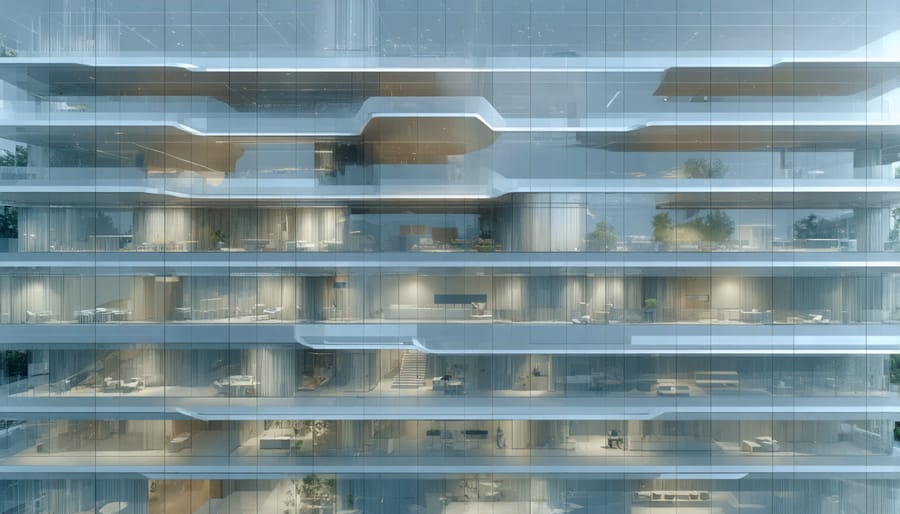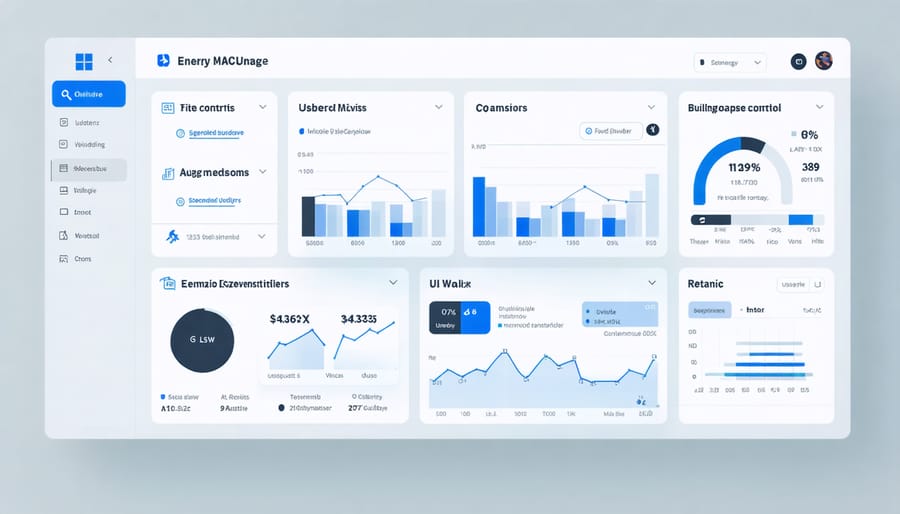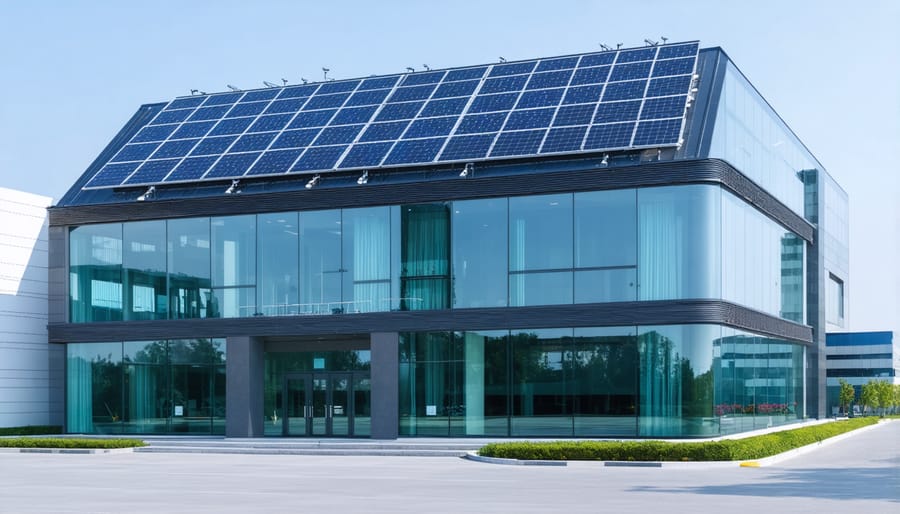Energy efficiency stands at the forefront of modern construction innovation, driving unprecedented changes in how we design, build, and operate structures. The integration of smart building technologies has transformed traditional construction practices into data-driven, sustainability-focused operations that deliver measurable results. With global energy consumption in buildings accounting for 40% of total energy use, the construction industry faces mounting pressure to implement effective energy-efficient solutions.
Recent advancements in building envelope technologies, coupled with sophisticated energy management systems, have enabled construction professionals to achieve up to 50% reduction in operational energy costs. These innovations, from advanced insulation materials to intelligent HVAC systems, represent not just environmental responsibility but compelling business opportunities. As regulatory requirements tighten and energy costs continue to rise, mastering energy-efficient construction techniques has become essential for industry leaders seeking to maintain competitive advantage while meeting increasingly stringent sustainability standards.
This strategic approach to energy efficiency demands a comprehensive understanding of both cutting-edge technologies and proven methodologies that deliver measurable returns on investment.

Smart Building Envelope Technologies
Dynamic Glazing Solutions
Dynamic glazing technologies represent a significant advancement in building envelope systems, offering unprecedented control over solar heat gain and daylight transmission. Electrochromic glass, the most widely adopted smart window solution, uses a small electrical charge to alter its tint level in response to changing environmental conditions or user preferences.
These intelligent glazing systems typically consist of multiple layers of specialized materials, including transparent conducting oxides and an ion-conducting layer. When voltage is applied, ions move between layers, causing the glass to change its optical properties. This process can reduce solar heat gain by up to 80% compared to conventional glazing, while maintaining visual clarity and connection to the outdoor environment.
Modern dynamic glazing solutions can be integrated with building automation systems, responding automatically to factors such as solar radiation, temperature, and occupancy patterns. Some advanced systems incorporate AI algorithms to optimize performance based on historical data and predicted weather conditions.
Implementation costs have decreased significantly in recent years, making these solutions increasingly viable for commercial projects. Studies indicate that dynamic glazing can reduce HVAC energy consumption by 20-30% in commercial buildings, with additional benefits including enhanced occupant comfort and reduced glare.
The technology also contributes to LEED certification points and helps meet increasingly stringent energy codes. Leading manufacturers now offer warranties exceeding 10 years, addressing previous concerns about long-term durability and performance reliability.
High-Performance Insulation Systems
Modern construction has witnessed significant advancements in insulation technology, with high-performance systems revolutionizing building envelope design. Aerogel-based materials, featuring nano-sized pores that minimize heat transfer, now offer thermal resistance values up to R-40 per inch – nearly twice the performance of traditional fiberglass insulation.
Vacuum Insulated Panels (VIPs) represent another breakthrough, delivering exceptional thermal resistance in ultra-thin profiles. These panels utilize a compressed core material sealed within a multilayer barrier film, achieving R-values of R-50 per inch when properly installed. However, they require careful handling during installation to maintain their performance integrity.
Phase Change Materials (PCMs) are gaining traction for their ability to regulate temperature fluctuations actively. These materials absorb and release thermal energy during state changes, effectively reducing HVAC loads during peak demand periods. When integrated with conventional insulation systems, PCMs can improve overall energy efficiency by 20-30%.
Installation techniques have evolved to match these advanced materials. Precision installation methods, including thermal imaging guidance and automated application systems, ensure optimal performance. Continuous insulation strategies, which eliminate thermal bridging through structural elements, have become standard practice in high-performance building envelopes.
These innovative systems, while initially more expensive than traditional options, typically demonstrate ROI within 3-5 years through reduced energy costs and increased building value.
Intelligent Energy Management Systems
AI-Powered HVAC Optimization
Modern AI-powered HVAC systems are revolutionizing energy efficiency in commercial and residential construction through advanced machine learning algorithms and predictive analytics. These systems continuously monitor and analyze multiple data points, including occupancy patterns, weather conditions, thermal loads, and historical performance metrics to optimize heating and cooling operations in real-time.
The integration of artificial intelligence enables predictive maintenance capabilities, allowing facility managers to address potential system failures before they occur. By analyzing performance data and identifying subtle changes in system behavior, AI algorithms can predict equipment maintenance needs with up to 95% accuracy, significantly reducing downtime and repair costs.
Recent case studies demonstrate that AI-optimized HVAC systems can reduce energy consumption by 20-30% compared to traditional systems. For example, a commercial office building in Chicago implemented smart HVAC controls that adjusted operation based on occupancy patterns and weather forecasts, resulting in annual energy savings of $175,000.
Key features of modern HVAC optimization include:
– Dynamic load balancing
– Zone-specific temperature control
– Automated fault detection and diagnostics
– Real-time energy consumption monitoring
– Adaptive scheduling based on occupancy patterns
The implementation of these systems requires initial investment in sensors, controllers, and software infrastructure. However, the return on investment typically occurs within 18-36 months through reduced energy costs and maintenance expenses. As technology continues to evolve, these systems are becoming increasingly sophisticated in their ability to maintain optimal comfort while minimizing energy consumption.
Real-Time Energy Monitoring
Real-time energy monitoring has emerged as a crucial component in modern construction projects, enabling unprecedented control over building energy consumption. Advanced sensor networks, integrated throughout the building’s infrastructure, continuously collect data on electricity usage, HVAC performance, lighting systems, and occupancy patterns.
These sophisticated monitoring systems utilize IoT-enabled devices that transmit real-time data to centralized building management platforms. Energy managers can track consumption patterns, identify inefficiencies, and implement immediate corrective measures through user-friendly dashboards. Machine learning algorithms analyze this data to predict usage trends and automatically adjust building systems for optimal performance.
Key components of modern energy monitoring systems include:
– Smart meters for granular electricity consumption tracking
– Occupancy sensors for demand-based system control
– Temperature and humidity sensors for HVAC optimization
– Power quality analyzers for electrical system efficiency
– Integration with building automation systems
The implementation of real-time monitoring typically results in 15-30% energy savings within the first year. For instance, a recent commercial office project in Seattle achieved 27% reduction in energy costs after deploying an advanced monitoring system with predictive analytics capabilities.
Data analytics plays a vital role in translating raw sensor data into actionable insights. Modern platforms can identify anomalies, generate automated reports, and provide recommendations for energy optimization. This data-driven approach enables facility managers to make informed decisions about energy usage, maintenance schedules, and system upgrades, ensuring continuous improvement in building performance while maintaining optimal comfort levels for occupants.

Renewable Energy Integration
Building-Integrated Photovoltaics
Building-Integrated Photovoltaics (BIPV) represents a significant advancement in sustainable construction, seamlessly incorporating solar technology into building materials and architectural elements. Unlike traditional solar panel installations, BIPV systems serve dual purposes: they generate clean energy while functioning as integral building components such as roofing, facades, windows, or skylights.
Modern BIPV solutions include photovoltaic glass units that can replace conventional windows while maintaining transparency and thermal insulation properties. These systems typically achieve conversion efficiencies between 12% and 17%, depending on the technology used and installation conditions. Semi-transparent solar cells are particularly popular in commercial buildings, offering optimal daylighting while generating power.
The integration of BIPV during the design phase can significantly reduce overall construction costs compared to retrofitting traditional solar panels. According to recent industry studies, BIPV systems can offset their installation costs within 7-10 years through energy savings and reduced material costs.
Recent technological advances have improved the aesthetic appeal of BIPV, with manufacturers now offering customizable colors and textures that match traditional building materials. This development has been particularly valuable for projects in historically sensitive areas where visual integration is crucial.
For optimal performance, BIPV systems require careful consideration of orientation, shading patterns, and local climate conditions during the planning phase. Successful implementation often involves collaboration between architects, electrical engineers, and construction specialists to ensure seamless integration with building systems.

Energy Storage Solutions
Modern construction projects increasingly rely on advanced energy storage solutions to optimize power consumption and enhance grid reliability. Battery systems, particularly lithium-ion installations, have become integral components in commercial and residential buildings, enabling effective load shifting and peak demand management.
These storage systems work in conjunction with smart grid technology, allowing buildings to store excess energy during off-peak hours and utilize it during high-demand periods. This capability not only reduces operational costs but also provides crucial backup power during outages. Advanced battery management systems (BMS) monitor and optimize performance while ensuring safe operation and extended battery life.
Integration with building management systems (BMS) enables automated control of energy flow, maximizing the efficiency of renewable energy sources such as solar panels and wind turbines. Smart inverters facilitate bidirectional power flow, allowing buildings to participate in demand response programs and potentially generate revenue through grid services.
Recent technological advances have improved battery density and reduced costs, making storage systems increasingly viable for construction projects of all sizes. Modular designs allow for scalability, while improved thermal management systems enhance safety and reliability. When combined with predictive analytics and machine learning algorithms, these systems can anticipate energy needs and optimize storage capacity utilization, resulting in significant operational cost savings and improved building resilience.
Cost-Benefit Analysis
Implementing energy-efficient measures in construction projects requires careful financial analysis to justify the initial investment. Our research indicates that while upfront costs can be 10-15% higher than traditional construction methods, the long-term cost savings typically offset these expenses within 3-7 years.
Recent data from the International Energy Agency (IEA) demonstrates that energy-efficient buildings can reduce operational costs by 30-50% compared to conventional structures. For a typical commercial building, this translates to annual savings of $0.50-$1.25 per square foot in energy costs alone.
Consider these key financial metrics:
Initial Investments:
– High-performance insulation: $2-4 per square foot
– Energy-efficient windows: 15-20% premium over standard options
– Smart HVAC systems: 25-30% higher initial cost
– LED lighting systems: 30-40% more than traditional lighting
Return on Investment (ROI):
– Building envelope improvements: 3-5 years
– HVAC upgrades: 4-6 years
– Lighting systems: 2-3 years
– Smart building controls: 3-4 years
Maintenance and lifecycle costs also factor significantly into the analysis. Energy-efficient systems typically require less frequent replacement and maintenance, reducing operational expenses by 15-25% over their lifetime. Additionally, many jurisdictions offer tax incentives, rebates, and grants that can offset initial costs by 20-30%.
Market value considerations further strengthen the business case. Energy-efficient buildings command 7-10% higher rental rates and maintain 15-20% higher property values compared to standard buildings. Furthermore, they experience lower vacancy rates and faster lease-up periods, enhancing overall return on investment.
For maximum financial benefit, construction professionals should prioritize improvements based on ROI potential and building-specific factors. Energy modeling and lifecycle cost analysis tools can help optimize investment decisions and ensure the most cost-effective implementation strategy.
As we look to the future of construction, energy efficiency has emerged as a cornerstone of sustainable building practices. The industry has made significant strides in developing and implementing innovative solutions that reduce energy consumption while maintaining optimal building performance. From advanced building automation systems to breakthrough insulation materials, these developments are reshaping how we approach construction projects.
The integration of smart technologies, improved building envelope designs, and renewable energy systems has demonstrated that substantial energy savings are achievable without compromising functionality or comfort. Case studies across various climate zones have consistently shown that energy-efficient buildings can reduce operational costs by 30-50% compared to conventional structures while providing superior indoor environmental quality.
Looking ahead, the construction industry is poised for further transformation. Emerging technologies such as AI-driven energy management systems, advanced thermal storage solutions, and next-generation building materials will continue to push the boundaries of what’s possible in energy-efficient construction. The growing emphasis on carbon neutrality and stricter energy codes will likely accelerate the adoption of these innovations.
For construction professionals, staying informed about these developments and maintaining expertise in energy-efficient practices is no longer optional but essential. As we move toward a more sustainable future, the success of construction projects will increasingly depend on their ability to maximize energy efficiency while meeting the evolving demands of clients and regulatory requirements.

